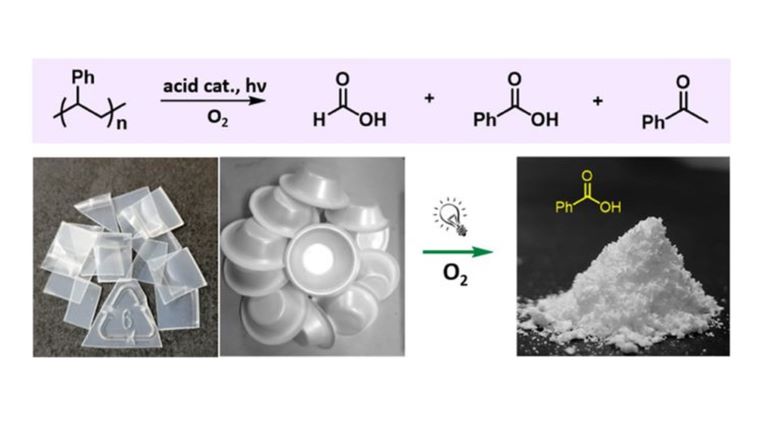Upcycling waste polymer to value-added chemicals

Synthetic plastics have been widely used to improve the quality of people’s lives. A big challenge is that most of them are not recycled and do not degrade, causing severe environmental issues, such as soil and water contamination and air pollution. An example is polystyrene (PS), which has been widely used in our daily life from building materials, electronics, protective packaging, to food containers. Tens of millions of tonnes of PS are produced annually, but most are not recycled. Since all atoms of PS are connected by strong C−C and C−H bonds, PS is remarkably inert and difficult to degrade. Whilst pyrolysis methods have been developed for recycling of PS, they are generally energy intensive.
A novel chemical recycling method has now been developed by the group of Xiao and collaborators. Driven by light, a simple Bronsted acid is found to catalyze the oxidative cleavage of various waste PS to valuable chemicals, such as benzoic acid and formic acid, under 1 bar of O2. Requiring no photosensitizers and only mild reaction conditions, the protocol is operationally simple, and has also been demonstrated in a flow system. EPR and DFT investigations indicate that singlet oxygen, produced probably by an acid-PS adduct acting as a photosensitizer, is the reactive oxygen species, which abstracts a hydrogen atom from a tertiary C-H bond in PS, leading to hydroperoxidation and subsequent C-C bond cracking events. “The novel approach and mechanistic understanding offered in this work could be pivotal in upcycling polystyrene materials on an industrial scale, incentivizing better recovery and management of the millions of tons of annual polystyrene waste”, as commented in JACS Spotlights.
The research was mainly carried out by Dr Zhiliang Huang of the Xiao group, involving collaborations with the groups of Eric McInnes (Manchester), Xiaotian Qi (Wuhan University), Jose Lopez-Sanchez and Anna Slater and with Vapourtec Ltd. The work was supported by the EPSRC (EP/R009694/1 and EP/R511729/1). It follows on from previous studies on O2 activation and selective oxidation in the group, J. Am. Chem. Soc. (2021, 143, 10005−10013; 2015, 137, 8206−8218; 2014, 136, 8350−8360).
The work has been published in J. Am. Chem. Soc. (2022, 144, 6532–6542) and featured in C&EN, ChemistryViews, and JACS Spotlights.